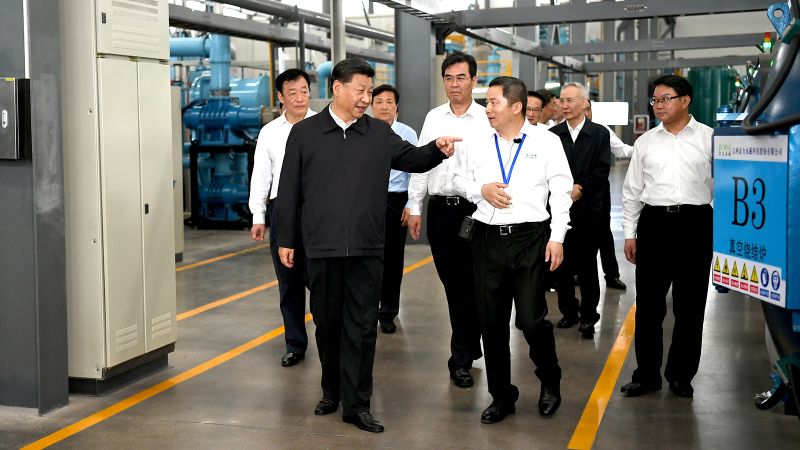In recent years, the geopolitical landscape has significantly shifted, prominently influenced by a persistent trade rivalry between the United States and China. This rivalry saw a marked escalation during Donald Trump’s administration, beginning with imposing tariffs on Chinese goods. Notably, as Trump initiated a trade war, Xi Jinping, the leader of China, made a conspicuous visit to a relatively unnoticed factory situated in Ganzhou, a small industrial city in southeastern China. In 2019, during this visit, Xi emphasized the importance of rare earth elements (REEs), declaring them as essential strategic resources.
Fast forward several years, China’s supremacy in the rare earth supply chain has emerged as an increasingly crucial leverage point against the United States. Rare earths, which include a group of 17 elements pivotal for advanced technologies—from smartphones to electric vehicles—have become integral to the technology sector that shapes tomorrow’s innovations. What complicates the situation further for the United States is that, unlike the tariffs it may employ in trade disputes, retaliation in the rare earth sector presents significant challenges.
Rare earths may seem more plentiful than gold, yet their extraction and processing are notoriously complex, costly, and have severe environmental ramifications. For decades, the U.S. has relied heavily on China’s processed rare earth products, with China accounting for 61% of global mined production and a staggering 92% of global processing capabilities, as reported by the International Energy Agency. This stark dependency placed the U.S. in a precarious position, particularly as China began to tighten its grip on exports in retaliation for Trump’s tariffs.
In April 2023, China imposed export restrictions on seven types of rare earth minerals, requiring companies to seek governmental permission before exporting not only these minerals but also products containing them—such as magnets essential for various industries, including defense technology. This strategic maneuver effectively illustrated China’s ability to wield significant economic power, aiming specifically to disrupt and impact key American industries. According to Justin Wolfers, an economics professor at the University of Michigan, this move represents a calculated effort by China to hit American industry where it counts.
Simultaneously, the U.S. has been striving to reduce its dependence on China’s supply. Since the onset of the Trump administration, initiatives to bolster a domestic rare earth supply chain have ramped up, with companies actively seeking to expand production capacities. However, building such a supply chain is a long-term endeavor and will take years to achieve the volume necessary to satisfy the demands from crucial U.S. industries.
On the ground, the ramifications of China’s export restrictions were immediate; American and European companies found shipments of rare earth magnets abruptly halted. This abrupt cessation caught many off-guard, leading to confusion and uncertainty regarding compliance with the new export licensing system. Joshua Ballard, CEO of USA Rare Earth, remarked on the predicament that these restrictions pose, as companies, now needing Beijing’s approval for vital materials, could find themselves significantly hampered in their operations.
Historically, China began its journey in the rare earth sector in the 1950s, capitalizing on low labor costs and turning to foreign technology. By integrating innovations from nations like the U.S., Japan, and Europe, China progressively enhanced its capabilities. Deng Xiaoping, a pivotal figure in Chinese economic reform, prophesized the strategic importance of rare earths, famously stating that while the Middle East possesses oil, “China has rare earths.” Today, China’s policy and investment strategies have solidified its global dominance in this sector.
The U.S. recognizes the challenge posed by China’s dominance and is actively looking to reshuffle the supply dynamics. Since 2020, the Department of Defense has aimed to establish robust domestic supply chains, investing substantial resources to ensure that the U.S. can produce its own rare earth materials by the 2027 deadline. American firms are now viewing the restrictions as a crucial opportunity, pushing for domestic expansion.
Nicholas Myers, CEO of Phoenix Tailings, represents a segment of American entrepreneurs developing new technologies to refine rare earths sustainably, with an emphasis on eliminating waste and emissions. Meanwhile, companies like USA Rare Earth are also making strides by establishing production facilities in Texas, signaling a shift toward regaining control of the rare earth supply chain.
In conclusion, the ongoing trade tussle and restrictions have created momentum within the United States to rejuvenate its own rare earth processing industry. With a recognized urgency to reclaim its technological sovereignty, American businesses may finally embark on the long overdue venture of reinvigorating expertise in the extraction and processing of rare earth materials. The push for self-sufficiency aligns with the larger objective of competing in an increasingly technology-driven world, where control of critical minerals will play a defining role in national well-being and global influence.



